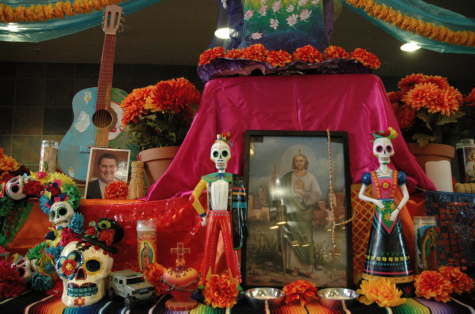Remember the dead at Día de los Muertos
October 31, 2019
Questions have arisen from students as to what exactly is located at the SURC pit.
From decorative sugar skulls to grand altars, Día de los Muertos (Day of the Dead) is a time where people can commemorate deceased loved ones.

The Day of the Dead features a mixture of indigenous cultural rituals and Catholicism brought by Spanish conquistadors. If a person is Latinx, this day can be celebrated differently depending on where they are from.
On Nov. 2, Día de los Muertos will be celebrated in the SURC Ballroom from 6-11 p.m. A procession will follow at 5 p.m. at Dean Hall.
Performances featured at the event will be Los Faraones del Norte, Mariachi del Centro and an Aztec Dance, which is a ceremonial dance to honor ancestral culture.
Daniel Cedeno, the president of Mariachi del Centro, talked about the importance of music to Día de los Muertos.
“There are different ways of showing the culture from the dance to the music,” Cedeno said. “I think that by having a Mariachi, it can showcase remembering someone through the music.”
Roziie Cardenas, a senior public services major, is the lead programmer for the event. Other team members who are helping at the event include those in charge of layout, decorations, the altar, publicity, food and entertainment.
“The goal behind what can be learned is for students of the Latinx community to feel a sense of belonging and a sense of cultural awareness,” Cardenas said.
For Cardenas, the highlight of the event last year was the band of Los Faraones Del Norte.
“A lot of people enjoyed them, they really got the crowd moving,” Cardenas said. “By inviting different performers, we were able to have variety and more collaboration. And those who went to the event were exposed to [CWU] student clubs and involvement.”
According to Cardenas, food options include rajas (jalapeno and cheese tamales), tamales de pollo (chicken tamales), and tamales de puerco (pork tamales).
Appetizers will be chicharrones (flour chips), arroz con leche (rice pudding), pan de muertos (bread) and bunuelos (fried tortilla). Drinks include chocolate de abuelita (hot chocolate) and horchata (rice, sugar and cinnamon drink).
Games will be hosted at the event, including Día de los Muertos Loteria (a game of chance), skull drawing, Kahoot and more.
An important decorative and meaningful piece is the sugar skull or “calavera”. According to the Day of the Dead website, the skull was a predominant symbol in indigenous culture. Today, it is used as an offering upon the altars.
“Ofrenda” or “altar” is a place where a picture can be placed for the people who have passed away along with their favorite food or drink. In the SURC Pit, there lies an altar where anyone can put a picture of a deceased loved one.
Another piece within the SURC Pit is the Sand Tapestry. The tapestry was made by Fulgencio Lazo, a well-known artist from Oaxaca, Mexico. This piece was built of weaved colored sand poured into glass.
This event was introduced by CWU alumni who were also a part of the Diversity and Equity Center (DEC). Verónica Gómez-Vilchis, an assistant director for the DEC, said when she got involved with the event she expanded the grandeur of it.
Oftentimes Día de los Muertos is confused with Halloween. From a distance, these holidays may seem similar, but they have completely different purposes.
“I think it is important to acknowledge that Día de los Muertos isn’t the same as Halloween. We want to be very careful to separate the two have different meanings and different purposes,” Gómez-Vilchis said.
For Gómez-Vilchis, a highlight from last year was the Aztec dance.
“This dance allows a tradition to be exposed in an intentional and representative of who they are,” Gómez-Vilchis said.
Both Gómez-Vilchis and Cedeno said the event is open to all, whether they are Hispanic or non-Hispanic.
“This event is for anyone,” Cedeno said. “It doesn’t matter if you are of Hispanic descent. You can enjoy music, food, culture and dance. Just by going you will understand why it is celebrated and why we try our best to remember those who have passed away.”
Cardenas also said anyone can attend the event.
“I hope for everyone to have a good time, experience the culture and embrace life. We all can be united as a community and have a good time. And for those who are not a part of the Latinx community to get a sense of the Latinx Culture and learn and celebrate their lost loved ones,” Cardenas said.
To volunteer for setup, students can register through the Center for Leadership and Community Engagement (CLCE) website. This event is sponsored by CWU Catering, CLCE, the CWU World Languages Department and more.

